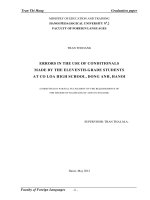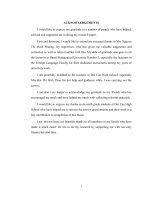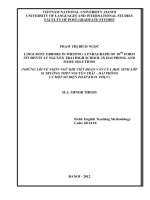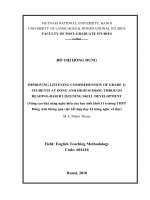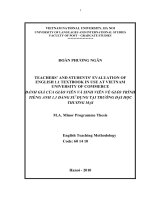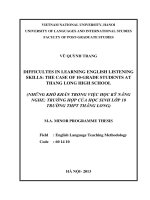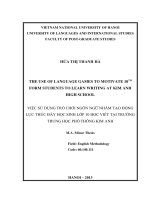The effects of teacher direct and indirect corrective feedback on grammatical errors in the writings of 10th grade students at kim anh high school
Bạn đang xem bản rút gọn của tài liệu. Xem và tải ngay bản đầy đủ của tài liệu tại đây (866.16 KB, 71 trang )
VIETNAM NATIONAL UNIVERSITY, HANOI
UNIVERSITY OF FOREIGN LANGUAGES AND INTERNATIONAL STUDIES
FACULTY OF POST-GRADUATE STUDIES
PHÙNG THỊ BÍCH NGUYỆN
THE EFFECTS OF TEACHER DIRECT AND INDIRECT CORRECTIVE
FEEDBACK ON GRAMMATICAL ERRORS IN THE WRITINGS
OF 10TH GRADE STUDENTS AT KIM ANH HIGH SCHOOL
Ảnh hưởng của hình thức phản hồi trực tiếp và gián tiếp
của giáo viên đối với việc sửa các lỗi ngữ pháp trong bài viết
của học sinh lớp 10 trường THPT Kim Anh
MASTER’S THESIS
Major: English Teaching Methodology
Major code: 60140111
Program: 1
Supervisor: Hoàng Thị Xuân Hoa, PhD.
HANOI - 2015
ACKNOWLEDGEMENTS
Firstly, I would like to express my gratitude to my supervisor, Ms. Hoang Thi
Xuan Hoa, PhD. for her helpful guidance, critical comments and enthusiastic support.
I would not have been able to complete this thesis without her great encouragement.
I am indebted to my colleagues for their valuable assistance for the pursuit and
fulfillment of this course.
My heartfelt thanks go to the students who willingly spent their time
participating in the study.
Last but not least, I owe a great debt of gratitude to my beloved family
members and close friends, who always stand by me no matter what happens.
i
ABSTRACT
This study investigated the effects of teacher written direct and indirect
corrective feedback on 10th grade students‟ three types of grammatical errors, namely
verb tenses and forms, attitudinal adjectives and articles, in their writings. Forty five
students were randomly assigned into three groups and received direct corrective
feedback, indirect corrective feedback and no feedback respectively. Students in each
group produced three narrative paragraphs (a pretest, a revision, a post-test). The
results of data analysis showed that both direct and indirect corrective feedback helped
participants reduce errors related to verbs and attitudinal adjectives from the pretest to
the post-test. However, only direct feedback contributed to a significant reduction of
article errors from the pretest to the post-test. Between group comparisons of the posttest results revealed that direct corrective feedback appears to be slightly more
effective than indirect corrective feedback in helping participants reduce errors related
to verbs and attitudinal adjectives. In addition, the effect brought about by direct and
indirect feedback on reducing article errors compared to the control group was not
statistically significant. The findings are discussed in the context of the related
literature and areas of future research are suggested.
ii
TABLE OF CONTENTS
Acknowledgements .............................................................................................. i
Abstract ................................................................................................................ ii
List of Tables........................................................................................................vi
List of Figures ......................................................................................................vii
List of Abbreviations............................................................................................vii
CHAPTER 1: INTRODUCTION
1.1. Statement of the problem and rationale of the study .................................... 1
1.2. Aims and objectives of the study .................................................................. 3
1.3. Significance of the study ............................................................................... 3
1.4. Scope of the study ......................................................................................... 4
1.5. Organization of the paper .............................................................................. 4
CHAPTER 2: LITERATURE REVIEW
2.1. Approaches to the teaching of L2 writing..................................................... 5
2.1.1 Product approach ...................................................................................5
2.1.2. Process approach ..................................................................................6
2.2. Grammatical errors in L2 writing ................................................................. 7
2.3. Feedback in L2 Writing ............................................................................... 8
2.3.1. Definition............................................................................................. 8
2.3.2. Types of feedback ............................................................................... 9
2.3.2.1. Direct Corrective Feedback .........................................................9
2.3.2.2. Indirect Corrective Feedback ......................................................10
2.3.3. Review on studies about feedback issues ........................................... 10
2.3.3.1. The effectiveness of corrective feedback .....................................10
2.3.3.2. The impacts of direct and indirect corrective feedback ...............12
CHAPTER 3: METHODOLOGY
3.1. Setting ...........................................................................................................15
3.2. Research method ...........................................................................................17
3.3. Participants ....................................................................................................15
3.4. Data collection ..............................................................................................16
iii
3.4.1. Data collection instruments ..................................................................16
3.4.2. Data collection procedure .....................................................................17
3.5. Data analysis .................................................................................................20
CHAPTER 4: RESULTS AND DISCUSSION
4.1. Pretest results ................................................................................................22
4.1.1. Verb errors in the pretest ......................................................................22
4.1.2. Errors of attitudinal adjectives in the pretest ........................................23
4.1.3. Errors of articles in the pretest ..............................................................24
4.2. Post-test results .............................................................................................25
4.2.1. Answer to the first research question ...................................................25
4.2.1.1. Verb tenses and forms .................................................................25
4.2.1.2. Attitudinal adjectives ...................................................................27
4.2.1.3. Articles .........................................................................................29
4.2.1.4. Summary of the results and discussion ........................................31
4.2.2. Answer to the second research question ...............................................32
4.2.2.1. Verb tenses and forms .................................................................33
4.2.2.2. Attitudinal adjectives ...................................................................34
4.2.2.3. Articles.........................................................................................36
4.2.2.4. Summary of the results and discussion .......................................37
CHAPTER 5: CONCLUSION
5.1. Summary of findings .....................................................................................38
5.2. Limitations of the study and suggestions for further studies ........................39
5.3. Implications ...................................................................................................39
REFERENCES
APPENDICES:
Appendix 1: Placement Test
Appendix 2: Pre-test
Appendix 3: Post-test
Appendix 4: Pretest result
iv
Appendix 5: Post-test result
Appendix 6: Students‟ writing samples
v
LIST OF TABLES
Table 3.1- Example of direct corrective feedback and indirect corrective feedback
Table 3.2.: Summary of data collection procedure
Table 4.1- Descriptives (Test 1 - Verb)
Table 4.2 - Test of Homogeneity of Variances (Test 1 - Verb)
Table 4.3 - ANOVA (Test 1 - Verb)
Table 4.4 - Descriptives (Test 1 – Adj)
Table 4.5 - Test of Homogeneity of Variances (Test1 - Adj)
Table 4.6 - ANOVA (Test1 - Adj)
Table 4.7 - Descriptives (Test1 - Article)
Table 4.8 - Test of Homogeneity of Variances (Test1 - Article)
Table 4.9 - ANOVA (Test1 - Article)
Table 4.10 - Paired Samples Statistics (Pair 1 – DF - Verb)
Table 4.11 - Paired Samples Test (Pair 1 – DF - Verb)
Table 4.12 - Paired Samples Statistics (Pair 2- IF - Verb)
Table 4.13 - Paired Samples Test (Pair 2 – IF - Verb )
Table 4.14 - Paired Samples Statistics (Pair 3 – NF - Verb)
Table 4.15 - Paired Samples Test (Pair 3 – NF – Verb )
Table 4.16 - Paired Samples Statistics (Pair 4 – DF – Adj)
Table 4.17 - Paired Samples Test (Pair 4 – DF – Adj)
Table 4.18 - Paired Samples Statistics (Pair 5 – IF – Adj)
Table 4.19 - Paired Samples Test (Pair 5 – IF – Adj)
Table 4.20 - Paired Samples Statistics (Pair 6- NF – Adj)
Table 4.21 - Paired Samples Test (Pair 6 - NF – Adj)
Table 4.21 - Paired Samples Test (Pair 6 - NF – Adj)
Table 4.22 - Paired Samples Statistics (Pair 7- DF – Article)
Table 4.23 - Paired Samples Test (Pair 7- DF – Article)
Table 4.24 - Paired Samples Statistics (Pair 8 - IF – Article)
Table 4.25 - Paired Samples Test (Pair 8 – IF – Article)
Table 4.26 - Paired Samples Statistics (Pair 9 – NF – Article)
vi
Table 4.27 - Paired Samples Test (Pair 9 – NF – Article)
Table 4.28 - Descriptives (Test 2 – Verb)
Table 4.29 - Test of Homogeneity of Variances (Test 2 – Verb)
Table 4.30- ANOVA (Test 2 – Verb)
Table 4.31 - Multiple Comparisons (Test 2 – Verb)
Table 4.32 - Descriptives (Test 2 - Adj)
Table 4.33 - Test of Homogeneity of Variances (Test 2 - Adj)
Table 4.34 - ANOVA (Test 2 - Adj)
Table 4.35 - Multiple Comparisons (Test 2 – Adj)
Table 4.36 - Descriptives (Test 2 – Article)
Table 4.37 - Test of Homogeneity of Variances (Test 2 – Article)
Table 4.38 - ANOVA (Test 2 – Article)
Table 4.39 - Multiple Comparisons (Test 2 – Article)
LIST OF FIGURES
Figure 3.1: Process of setting up groups
LIST OF ABBREVIATIONS
EFL: English as Foreign Language
ESL: English as Second Language
DF: Direct Feedback
IF: In Direct Feedback
NF: No Feedback
L2: Second Language
Adj: Attitudinal Adjective
vii
CHAPTER 1: INTRODUCTION
1.1. Statement of the problem and rationale of the study
Obviously, writing plays an important role in communication because apart
from speaking writing enables people to express their feelings and thoughts. They use
it to define themselves, clarify their knowledge and their ideas, to understand the
problems that may face them as well as to find solutions for such problems. Being so,
writing is a means for self-actualization. What people learn about themselves and
develop within themselves through writing can help them to realize their individual
potential and to achieve potential goals (Hughey, et al, 1983)
In the field of second and foreign language learning and teaching, writing has
been seen as essential integral part of any language syllabus as learning to write
effectively seems to be of prime importance.
Writing also enhances language
acquisition because learners experiment with words, sentences, and large chunks of
writing to communicate their ideas effectively and to reinforce grammar and
vocabulary they are learning in class (Bello, 1997). It helps to consolidate learning to
render it available for use in other areas such as listening, speaking and reading
(Mohamed, 2000).
In spite of the importance of writing, it is one of the most difficult language
skills to master. According to Richards and Renandya (2002), the difficulty lies not
only in generating and organizing ideas, but also in translating these ideas into readable
text. They argue that the skills involved in writing are highly complex, and learners
have to pay attention to higher level skills of planning and organizing as well as lower
level skills of spelling, punctuation, word choice, and so on. The difficulty becomes
even more pronounced if student writers are at a low level of language proficiency.
In Vietnam, of four skills that students learn in the subject of English, much
attention has been paid to developing writing skill. In 2005, the Ministry of Education
and Training decided to reform the structure of the English test in Vietnam National
High School Graduation Examination 2015 with more emphasis on the writing skill.
Accordingly, apart from multiple choice grammar questions, students were asked to
write a short paragraph. However, the result of the exam indicates that students‟
1
writing performance was generally poor as a large number of students could hardly do
the task. Regarding students‟ attitude towards learning writing, according to Le (2008)
(as cited in Pham (2009), only 6.9% of students wanted to learn writing. When asked
about the reality of English writing at a specialized high school in the Mekong Delta,
teachers reported that most of the students had problems with their writing such as (1)
students have few opportunities to respond to teacher feedback thoughtfully and
critically, (2) their written texts contain a lot of grammatical inaccuracies and (3) they
have negative attitudes toward writing in English. It can be seen that the teaching and
learning writing English in Vietnam seems to face considerable difficulties.
Given the importance of writing in communication and in the field of EFL
learning and teaching, the difficulties facing learners in developing their writing ability
over time in EFL contexts, a lot of research has been conducted in order to explore the
effects of various techniques on helping ELF learners become better writers, especially
the impact teacher feedback on students‟ writings. However, the controversy over the
effectiveness of corrective feedback remains unresolved. According to the most
extreme views, such as Truscott (2007), corrective feedback is seen as not only
ineffective but also potentially harmful. In contrast, a number of L2 researchers and
practitioners (e.g. Bitchener and Knoch, 2008; Chandler, 2003; Ferris, 2002; Sheen,
2007) claim that corrective feedback is of value in promoting greater grammatical
accuracy. Also, there have been studies that examined the relative effectiveness of
varying feedback types, and direct and indirect corrective feedback has received due
attention of researchers. To date, studies examining the effects of direct and indirect
feedback on L2 learners‟ writing have yielded mixed results. Furthermore, in Vietnam,
there is little research addressing the issue. Especially, most previous studies have
participants who are university students, and hardly any studies whose participants are
high school students can be found.
The above-mentioned reasons are the incentive for the researcher to conduct a
study on “The effects of teacher direct and indirect corrective feedback on
grammatical errors in the writings of 10th grade students at Kim Anh High
School”. The results of the study are expected to make a contribution to the ongoing
2
debate about the issue and to help the researcher to use corrective feedback more
effectively in the teaching of writing.
1.2. Aims and objectives of the study
The current study aims at investigating the effects of teacher direct and indirect
corrective feedback on grammatical errors in the writings of 10th grade students at Kim
Anh High School.
In order to achieve the aims, the study seeks to find the answer to the following
research questions:
1. Do teacher written direct corrective feedback and indirect corrective feedback
help 10th grade students at Kim Anh High School to reduce grammatical errors in
writing from an initial task to a new task?
2. If so, which kind of feedback (direct corrective feedback or indirect corrective
feedback) is more effective?
This study proposes the following hypotheses:
1. Teacher direct corrective feedback and indirect corrective feedback have
significant effect on helping 10th grade students at Kim Anh High School to
reduce grammatical errors in writing from an initial task to a subsequent task.
2. Teacher direct corrective feedback is more effective.
1.3. Significance of the study
Findings of this study will contribute to the discussion about whether or not
corrective feedback is effective and helpful in helping students reduce grammatical
errors in their subsequent writings.
Unlike some previous studies which did not have a control group, this study will
involve a treatment group receiving both teacher written indirect and direct corrective
feedback and a control group receiving no corrective feedback.
This study will also focus on three grammatical errors frequently made by EFL
students, which is different from several previous studies that were either too broad by
addressing too many areas of error or too specific by focusing only on one error.
3
As far as the teaching of writing is concerned, the study will also contribute to
the practice of teaching writing in EFL context. Findings of this study might be of
interest to foreign language writing teachers and researchers, especially those at
secondary and high schools. They may have better understanding of the effects of
teacher direct and indirect corrective feedback on students‟ writings; thence have more
suitable feedback strategies to help their students.
1.4. Scope of the study
The study is restricted to explore the effects of two strategies of feedback, direct
corrective feedback and indirect corrective feedback on grammatical errors made by
10th grade students. In addition, only three targeted grammatical errors were in this
research. They are the common types of grammatical errors and the ones that occurred
most frequently during the first writing task, including verb tenses and forms,
attitudinal adjectives and article usage.
Regarding the sample of the research, the participants were only selected from
10th grade students at Kim Anh High School in the school year of 2014-2015.
1.5. Organization of the paper
The study includes five chapters as follows:
Chapter 1 (Introduction) presents the problem and the rationale, the aims and
objectives, the scope and the significance of the study.
Chapter 2 (Literature review) provides the theoretical background of the study and
reviews related studies.
Chapter 3 (Methodology) describes the participants, the instruments and the procedures
to be employed to conduct the study.
Chapter 4 (Results and Discussion) answers the research questions with data
presentation, data analysis and the comparison among the finding themselves and the
assumptions discussed in the Literature Review.
Chapter 5 (Conclusion) summarizes the main issues discussed in the study, the
limitations of the research and some suggestions for further study.
4
CHAPTER 2: LITERATURE REVIEW
This chapter sheds lights on the literature review of the study, specifically some
approaches in teaching wiring, grammatical errors and teacher corrective feedback.
Firstly, an overview of approaches in teaching writing will be provided. Secondly,
grammatical errors will be discussed. Finally, a closer look will be cast into teacher
corrective feedback by outlining the main types of feedback, briefly reviewing main
previous research on the effectiveness of feedback and summarizing the key findings
of main studies.
2.1. Approaches to the teaching of L2 writing
There have been a number of ways of teaching writing. However, the two most
commonly and popularly known at the moment are the product-based approach and the
process-oriented approach (Nunan, 1995).
2.1.1. The product approach
The product approach emerged as a combination of structural linguistics and
behaviorist learning theory, which was popular in the 1960s (Silva, 1990). Product
approach is the traditional approach to teaching writing which focuses at the result of
the act of composition. The writing teachers who subscribe to the product approach are
more concerned to see what a final piece of writing will be like and measure it against
criteria of vocabulary use, grammar use, and medical considerations such as spelling
and punctuations, as well as content and organization (Brown, 1994). Students in the
classes adopting the product approach typically are given writing models to imitate
before they are evaluated by their teachers (Ferris and Hedgcock, 2005) and writing is
taught through four stages, which are familiarization, controlled writing, guided writing
and free writing.
Since the focus in the product approach is on form, it is easy to use with large
classes. It is also easier to mark compositions because the teacher can easily direct his
or her attention to the form while correcting. This approach is useful for situations
where the emphasis on form is important or where the focus on structure is the main
5
target. It has been widely used and teachers are quite familiar with it. It might also be
suitable for lower level learners because it helps them correct and eliminate their errors
(Tribble, 1996)
However, product approach has a number of limitations. First, as Ferris and
Hedgcock (2005) explain, this approach focuses on the writing structure and use of
vocabulary as the main indicators of writing development, neglecting the writing
processes that students go through in writing (pre-writing, drafting, revising and
editing). Second, it may create problems as it restricts the teaching of writing to
syntactic and grammatical accuracy, thus limiting students‟ understanding of good
writing (Hyland, 2003). Third, the focus on grammar skills has not proved to be
effective in improving writing ability and many researchers reject the emphasis on
grammar, arguing that it has little to do with the act of writing (Zamel, 1976). While
Hinkel and Fotos (2002) believe that grammar teaching can be helpful and productive
in ESL and EFL writing classrooms, other studies take the opposite view. Hudson
(2001) argues that to prove that teaching grammar improves writing, further research
needs to be carried out. Another weakness in the approach lies in the assumption that
good writing can be achieved by applying certain functional rules. In fact, writing is
much more than that (O‟Hare, 1973). Fourth, it restricts students‟ creativity as it relies
on imitation (Hyland, 2003). Fifth, the use of language in this approach is restricted to
fixed patterns that are learned by imitating other models (Pincas, 1962).
2.1.2 The process approach
The process approach came into existence in reaction to product approach
pedagogies (Miller, 1991). This approach leads students to the phase of a finished text
publication as it goes beyond linguistic knowledge to focus on linguistic skills and
involves identifiable stages (Merriwether, 1997). Reid (1993) describes writing as a
multi-stage process. Goldstein and Carr (1996) refer to the process of writing as a
range of strategies that include prewriting, planning, drafting and revising. (Hedge,
2005, as cited in Mohamed, 2013 ) explains that the process of composing a text goes
through different stages of revision, editing and generating such as being motivated to
6
write, getting ideas together, planning and outlining, making notes, making a first draft,
revising, editing and getting ready for publication (Hedge, 2005, as cited in Mohamed,
2013 )
Freeman and Freeman (2004) identify a number of advantages in the process
approach. First, it motivates students to deliver their own messages and become
creative. Second, it involves teachers and students in responses to texts through peer
feedback and discussions. Third, it deals with mistakes in writing skills such as spelling
and grammar through teacher-student conferencing. Fourth, it naturally moves writing
from invention to convention (i.e. writing becomes a practice of a set of cognitive
process instead of a demonstration of linguistic knowledge). However, the process
approach has some limitations. First, it is time-consuming, especially with large
classes. Second, teacher-student conferences could be difficult to schedule due to time
pressure. Third, it requires a great deal of marking. Fourth, it might discourage students
who are not familiar with the process writing as they may consider revision as failure
(Corpuz, 2011 )
2.2. Grammatical errors in L2 writing
Making errors is the most natural thing in the world and it is evidently attached
to the human beings (Beuningen, 2010). A number of experts in linguistics have
presented various definitions of error. Among them, Norrish (1983) considers error as a
systematic deviation, when a learner has not learnt something and consistently gets it
wrong. Ellis (1994) also defines error as a deviation from the norms of the target
language. To support this point, Ellis (1994) further clarifies that the standard written
dialect which is widely spread and used to teach non-native speakers is considered as
the norm particularly in language classroom settings. In short, the norms of the target
language are defined as the standard written dialect, and if so, error refers to the
deviation of that standard. Tsui (1995) considers an error in the classroom as (1)
something that is rejected by the teacher because it is wrong or inappropriate, (2)
something that the teacher does not want or (3) something that does not conform to the
rules which the teacher lays down.
7
Richard (1992) and Ellis (1994) have a quite similar view on distinguishing
between a mistake and an error. They explain that errors occur when learners do not
know the correct usage reflect gaps in learner knowledge whereas mistakes occur
because, in particular instance, learners are unable to perform what they know reflect
occasional failures in performance. In this sense, error refers to a deviation which
occurs when language learners have not yet acquired correct usage of the target
language.
Norrish‟s (1983) classified errors into three types, namely errors, mistakes and
lapses. An error is a systematic deviation which is made because the learner has not
learnt the correct form. After the learner is taught the language form, he may be able to
use it correctly or may not sometimes. The inconsistent deviation is termed mistake.
Another type of wrong usage, which is neither an error nor a mistake, is a lapse. A
lapse occurred due to lack of concentration, shortness of memory, fatigue, etc.
Although there are different definitions and types of errors, in this paper the
term “errors” is used to refer to both “errors” made when the learners try to do
something with the language they do not know and “mistakes” which occur when the
students have learned something but have forgotten it or are careless in their writings.
2.3. Feedback in L2 Writing
This section provides an overview of a variety of issues related to feedback in
L2 writing. Firstly, the definitions and importance of feedback are presented. Next,
different types of feedback are briefly introduced. Finally, key issues in feedback and
research studies are tackled, with emphasis on the effectiveness of different types of
corrective feedback on students‟ writing.
2.3.1. Definition
Feedback is defined as teacher's input to a writer's composition in the form of
information to be used for revision (Keh, 1990). Nicol and Macfarlane (2004) consider
feedback as information provided by teachers to help students trouble-shoot their
performance. The writer of this paper would define it as teacher's response to students'
8
writing in the form of written comments that aim to help students improve their writing
performance.
Providing feedback is an essential function of teaching and learning (Beuningen,
2010). The importance of feedback is also stressed by Cole and Chan (1994). They
stated that feedback may serve not only to let learners know how well they have
performed but also to increase motivation and build a supportive classroom climate.
Providing the right kind of feedback to the students can make a significant difference
in their achievement.
2.3.2. Types of feedback
Although feedback is classified into some different types, this part only presents
key points about teacher direct corrective feedback and teacher indirect corrective
feedback, which are the focus of this study.
2.3.2.1. Direct Corrective Feedback
Direct corrective feedback is defined as a type of correction that draws students'
attention to the error and provides a solution to it (Bitchener and Ferris, 2012). In other
words, the teacher shows students where their errors are and corrects these errors by
providing the correct form. This type of correction takes a variety of forms such as
a) cross-outs: when the teacher omits any wrong addition from students‟ original texts,
b) rewrites: when the teacher rewrites a word, phrase or a sentence, providing the
correct spelling, structure or form on students‟ original texts and
c) additions: when the teacher adds any missing items on students‟ original texts (e.g.
prefix, suffix, article, preposition, word, etc).
Direct corrective feedback aims to help students edit their writing and improve
their performance in future tasks (Bitchener and Ferris, 2012). Ferris (2002) argues that
it is useful in treating errors of prepositions and other issues of idiomatic lexis. She also
claims that it is useful in the final stages of the writing process to help students focus
on the remaining errors in their texts and refer to them in future tasks. Students'
linguistic proficiency is important to determine the amount of direct corrective
feedback they receive as advanced learners are more likely to benefit from it.
9
2.3.2.2. Indirect Corrective Feedback
Indirect corrective feedback refers to situations when the teacher marks that
errors have been made but does not supply the correct forms, requiring the learners to
diagnose and correct their errors. (Lee, 2005). When giving
indirect corrective
feedback the teacher underlines, circles or highlights errors on students' original texts
to indicate the location of these errors without correcting them. Students are asked to
study their errors and correct them (Ferris, 2002). In other words, indirect corrective
feedback emphasizes the role of students in understanding and correcting their errors
rather than being provided with the corrections.
Indirect feedback is applied by underlining students' writing errors so that
students understand that there is a problem that should be 'fixed.' Teachers may use
lines, circles or highlighting to indicate the location of errors. They also need to decide
how explicit indirect feedback should be based on the goals they want to achieve by
providing feedback.
2.3.3. Review on studies about feedback issues
This section briefly reviews main studies about corrective feedback. According
to their research issues, studies are divided into two major groups namely the
effectiveness of corrective feedback and the impacts of direct and indirect feedback.
2.3.3.1. The effectiveness of corrective feedback
The discussion regarding the effectiveness of feedback has been prominent in
recent years.
Attitudes toward corrective feedback have evolved from the strict
avoidance of errors and thus quick and direct error correction before the 1960s, to the
condemnation of error correction as something harmful in the late 1960s, and to a more
critical view of the necessity and value of error correction in the 1970s and 1980s. The
controversy over the topic of corrective feedback, however, remains unresolved in the
1990s (Lee, 1997, cited in Khatib & Bijani, 2012, p. 103).
The heated debate on the effectiveness of corrective feedback in L2 writing was
initiated in 1996 in an article by Truscott (1996), who argued that grammar correction
should be avoided in L2 writing and stressed that teachers should not correct grammar
10
because of its potentially harmful impacts. He presented three arguments against error
correction. The first was that the learning process was too complex to believe that
students could improve through providing them with corrective feedback. Secondly,
giving corrective feedback to students at a time when they were not ready to learn a
specific language form or structure was barely possible. Thirdly, he argued that
whatever knowledge students acquired as a result of correction would dissipate over a
short period. These arguments led to an increase of research focusing on the
effectiveness of corrective feedback on students‟ writing.
Some researchers (e.g., Cohen and Robbins, 1976; Kepner, 1991; Sheppard,
1992; Polio et al. 1998) also claim that grammar corrections do not have a positive
effect on the development of L2 writing accuracy. According to the most extreme
views, such as Truscott (2007), corrective feedback is seen as not only ineffective but
also potentially harmful.
In contrast, a number of L2 researchers and practitioners (e.g. Bitchener and
Knoch, 2008; Chandler, 2003; Ferris, 2002; Sheen, 2007) claim that corrective
feedback is of value in promoting greater grammatical accuracy. For example, Ferris
(1995, 1999, 2003, 2004) have rejected the argument raised by Truscott with respect to
the ineffectiveness of implementing written corrective feedback on L2 learners‟
writing. Ferris (1999) argues that Truscott‟s stance against grammar correction and
ineffectiveness of corrective feedback on fostering L2 learners‟ writing ability is
premature. She claims that corrective feedback is an integral constituent of L2 writing
instruction. Furthermore, it is claimed that corrective feedback provides L2 learners
opportunities to notice the gaps in their L2 knowledge which in turn leads them to test
inter-language hypotheses and engage in meta-linguistic reflection which results in
prompting L2 writing (Van Beuningen, 2010). Ferris also argues that corrective
feedback is an inseparable issue in writing pedagogy and L2 researchers and
practitioners are assumed to focus on questions with respect to effective
implementation of corrective feedback.
Chandler (2003) also argued that students who received corrective feedback
then revised their writing improved over time.
11
In their studies, (Ashwell, 2000; Ferris, 1997; Ferris & Roberts, 2001; Sachs &
Polio, 2007) also found that participants whose errors were corrected were able to
make more accurate revisions than those who did not receive any corrective feedback.
However, results from studies investigating the effect of corrective feedback on
subsequent writing (e.g. Chandler, 2003; Kepner 1991; Polio et al., 1998; Semke,
1984), are inconclusive.
2.3.3.2. The impacts of direct and indirect corrective feedback
There are some studies that examined the relative effectiveness of varying
feedback types, and direct and indirect corrective feedback has received due attention
of researchers. To date, studies examining the effect of direct and indirect feedback on
L2 learners‟ writing have yielded mixed results.
It has been claimed that students would benefit more from indirect corrective
feedback because they have to engage in a more profound form of language processing
as they are self-editing their output (e.g. Ferris, 1995). However, this hypothesis could
not yet be confirmed since results from studies exploring the relative effectiveness of
direct and indirect corrective feedback (e.g. Chandler, 2003; Ferris et al., 2000;
Frantzen, 1995; Lalande, 1982, Robb et al., 1986) are inconclusive.
A study by Lalande (1982) showed that students who received indirect
corrective feedback outperformed students in a direct correction group. Pham (2009)
also concluded that indirect feedback was more effective than direct feedback in
helping reduce students‟ grammatical errors significantly. Frantzen (1995) and Robb et
al. (1986) on the other hand, found that direct and indirect corrective feedback were
equally effective. A study by Ferris et al. (2000) revealed yet another pattern; whereas
indirect correction proved to be most effective in improving students‟ accuracy in
subsequent writing, students who received direct feedback made the most accurate
revisions. Finally, as opposed to Lalande (1982) and Ferris et al. (2000), Chandler
(2003) found that direct corrective feedback resulted in the largest accuracy gains, not
only in revisions but also in subsequent writing.
Van Beuningen et al. (2012) investigated the effectiveness of direct and indirect
corrective feedback on students‟ overall accuracy, grammatical accuracy, non-
12
grammatical accuracy, grammatical complexity and lexical diversity in L2 writing. The
result of the study showed that direct and indirect feedback was useful in improving
grammatical and non-grammatical accuracy as both experimental groups outperformed
the control groups. For overall accuracy, the effect of direct corrective feedback was
greater than indirect corrective feedback. For grammatical complexity and lexical
diversity, Van Beuningen et al. (2012) wanted to examine Truscott‟s (2007) claim that
corrective feedback resulted in simplified writing. However, no significant difference
was found between all groups in structural complexity or lexical diversity.
While a lot of studies make claims about the effectiveness and ineffectiveness of
corrective feedback, the results of studies are controversial.
Studies that did include a control group and investigated the short-term
effectiveness of error correction (e.g. Ashwell, 2000; Ferris, 1997; Ferris & Roberts,
2001; Sachs & Polio, 2007), found that participants whose errors were corrected were
able to make more accurate revisions than those who did not receive any corrective
feedback. In contrast, results from studies investigating the effect of corrective
feedback on subsequent writing (e.g. Chandler, 2003; Kepner 1991; Polio et al., 1998;
Semke, 1984), are inconclusive. Methodological shortcomings might explain the
contradicting findings of these studies.
Semke (1984), who compared the effects of error correction to the effects of
content-focused comments, found that error correction had no effect on students‟
accuracy and a negative effect on their written fluency. However, in his research,
groups received different treatments in terms of time. Students in the content-focused
condition had twice as much time to produce new material than students receiving
corrective feedback. Therefore, it might be the case that these results could be
explained by the different amount of writing practice between the two treatment
groups.
Polio et al.‟s (1998) study showed that both students who received corrective
feedback and students who did not were able to improve their accuracy over time.
However, students in the experimental condition only produced half as many journal
entries as the control group did, because of the editing activities they had to perform.
13
Thus, it can be seen that the control group have more practicing opportunities and as a
result, they might have better performance. Perhaps, that is why the beneficial effects
of corrective feedback could not be significant.
Kepner (1991) did not find any significant differences in error-counts between a
group that received error corrections and another group that received message-related
comments. However, the participants in his research were not required to do anything
with the corrective feedback they received. Hence, it remains unclear whether the
students processed the feedback that they had received or not.
In Semke (1984) and Polio et al.‟s (1998) studies the fact that less time was
allocated to writing practice in the error correction condition than in the control
condition could explain why no positive effects of corrective feedback were found
In another experiment in which college learners who were required to write five
essays that were collected every second week, Chandler (2003) found that getting the
teacher to correct or to underline for learner self-correction resulted in a significant
improvement in both accuracy and fluency in subsequent writing of the same type.
Nevertheless, direct correction led to the greatest accuracy in comparison with indirect
corrections including underlining, description and underlining with description. Yet, as
learners were receiving different types of feedback in rotation, learning would have
occurred between treatments. Learners who received the direct correction treatment last
might perform very differently from those who had received it first. For example,
having experimented with the three other feedback types, learners alerted to the fact
that they should continue paying attention to their errors. In other words, the direct
correction type might have proven so effective because it was combined with other
feedback treatments. This study should be conducted with four different groups,
working with the same teacher but without alternating treatment in order to see the
effectiveness of direct correction.
In short, although there has been a great deal of arguments for and against the
efficacy of implementing corrective feedback on enhancing L2 writing, yet there is
little available to reach to a firm conclusion. Therefore, more studies should be conduct
to investigate different aspects of corrective feedback.
14
CHAPTER 3: METHODOLOGY
3.1. Setting
The study is conducted in 10th grade of Kim Anh High School which is located
in a rural area of Soc Son District, a developing suburb of Hanoi. In order to get the
admission to the school, students have to take a high school entrance exam delivered
annually by Department of Education and Training of Hanoi. However, the
examination consists of only two tests, including Mathematics and Literature test. It
means that all students are not required to take any tests of English in order to enter
Kim Anh High School. That is why a number of students do not pay adequate attention
to learning English at secondary school, and consequently their English level is lower
than what is expected for 10th grade students.
At Kim Anh High School, students have a 45-minute period of writing after
each two weeks. The writing lessons generally follow activities given in the textbook
“Tieng Anh 10” provided by the Ministry of Education and Training.
3.2. Method
To investigate the effects of teacher direct and indirect corrective feedback on
participants‟ grammatical accuracy in writing, a quasi-experimental study with one
independent variable and one dependent variable was employed.
The independent variable in this study was the teacher written corrective
feedback strategies. This variable comprised three levels namely direct feedback (DF),
indirect feedback (IF) and no feedback (NF). The dependent variable was participants‟
writing grammatical accuracy as measured by the percentage of errors in the writing
task 1 (pretest) and writing task 2 (post-test).
3.3. Participants
The participants of this study were 45 students from ten 10th grade classes. In
order to choose participants who are representatives of the desired population, these
students were selected from 10 classes based on their English scores. More
15
specifically, 63 students having English score at 10th grade of about from 7.0 to 7.5
coming from 10 classes were selected. Because their English scores were based on
different tests designed by different teachers, there might be a difference in the English
proficiency of these participants. Therefore, a placement test for these 63 students was
necessary to select students with quite similar level of English proficiency. As a rule,
students of Kim Anh High School have to take a placement test of English, Math,
Literature, Physics, Chemistry after 10th grade so that they can be placed into suitable
groups corresponding to their levels. Therefore, the researcher used the results of this
test to select 45 participants from these 63 students. More specifically, only 59 out of
63 students selected sat for the English test. In addition, the 14 test takers whose scores
were significantly higher or and lower than the others‟ were not invited to participate in
the study. As a result, 45 students were selected.
All participants have been learning English as a compulsory subject at school
for 7 years. During the time of the study, participants were having summer vacation
and were not taking any English classes at school.
3.4. Data collection
3.4.1. Data collection instruments
Three data collection instruments, including an initial writing test (pretest), a
revision of the initial task and a subsequent writing task (post-test), were employed in
the study.
Two writing tasks were used in the experiment. Both initial task (pretest) and a
subsequent writing task (post-test) were of a similar type – writing a narrative about an
embarrassing situation on the basis of a series prompts given. Students were instructed
to use about 100-120 words for each writing task. These writing tasks were also
designed in such a way that the content was unproblematic for all students, since the
aim of this study was to elicit the effect of the direct and indirect corrective feedback
on grammatical accuracy. The topic of the two writing tasks was similar because a
learner‟s language proficiency may not be the only factor influencing students‟
performance on a particular writing task. Research on writing assessment showed that
16
other factors, such as a task‟s topic, might also contribute to a writer‟s score
(Schoonen, 2005). Therefore, participants were given two different writing tasks of a
same topic so that topic influence factor can be controlled.
Before having been used officially, the tests were piloted among 6 participants
who were of similar backgrounds as those in the official study.
3.4.2. Data collection procedure
The data collection procedure consists of 6 main steps presented as follow:
Step 1: Selecting participants
The researcher informed the teachers of the aims of the research, what the
participants were expected to do to select students who had the English score at grade
10th of 7.0 -7.5.
Step 2: Administering placement test and setting up groups
To enhance the equivalence of student starting performance level of writing
among the groups at the beginning of this study, all participants took an English test
which assessed participants‟ overall language proficiency. After this test, 45 students
out of 59 students whose test score were not significantly different were selected.
Based on the performance level of the placement test, the students were
classified into low to moderate and moderate to high score groups. Students were then
randomly assigned in three different groups, including (Direct corrective feedback
(group 1) and indirect corrective feedback (group 2) and control group with no
feedback (group 3), using a stratified random sampling technique. After this stratified
random assignment, each treatment group had 15 students consisting of students drawn
from the low to moderate English proficiency level group and students from the
moderate to high proficiency level group. These steps are outlined in Figure 3.1.In this
way, it was expected that each group would have similar compositions of students with
similar levels of English.
17

